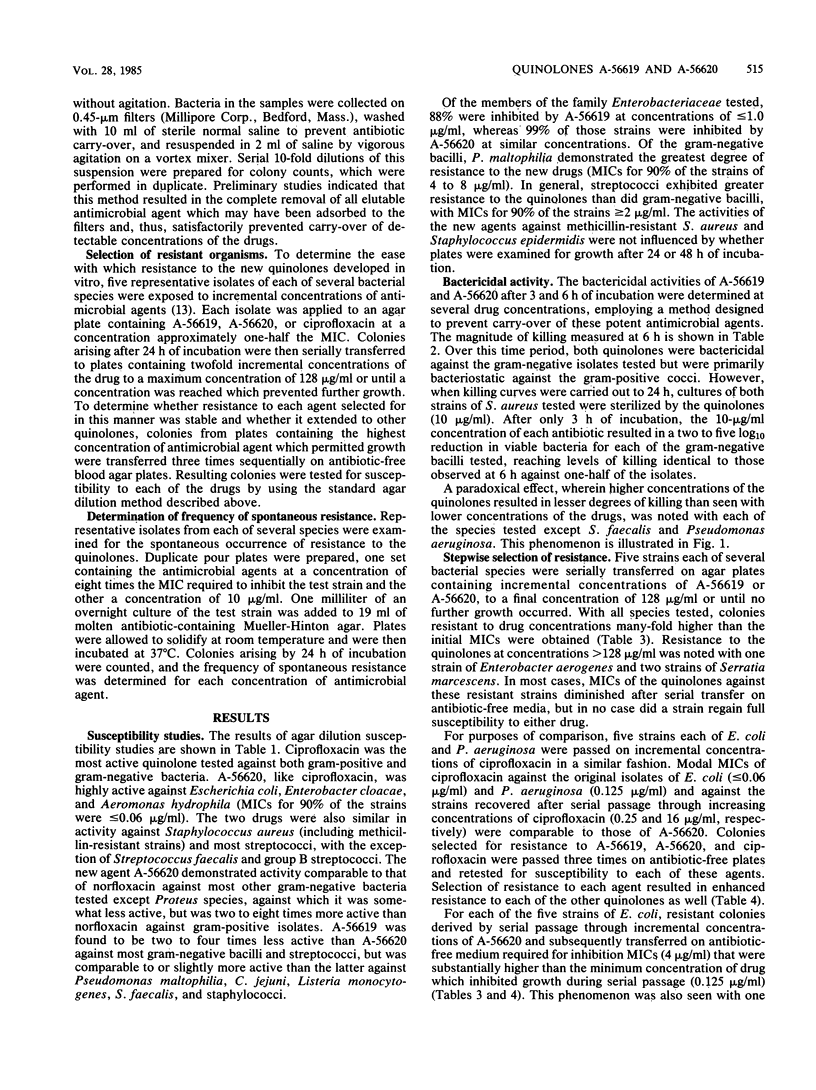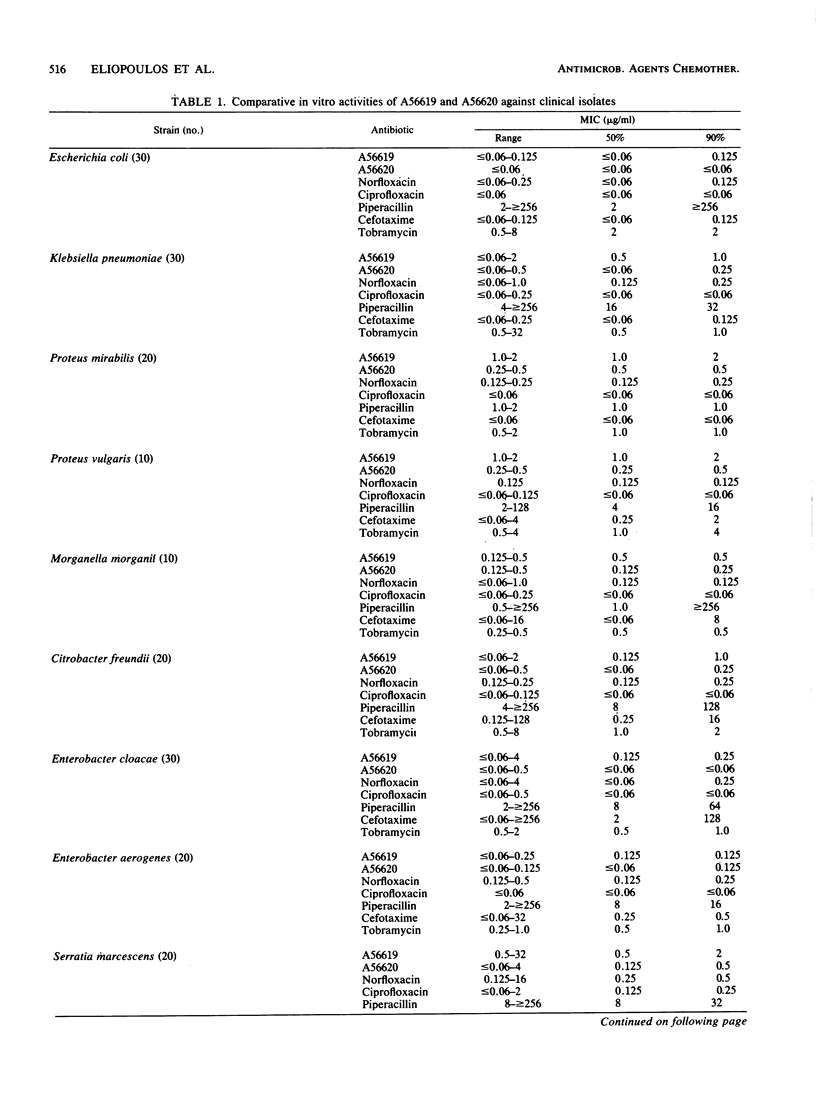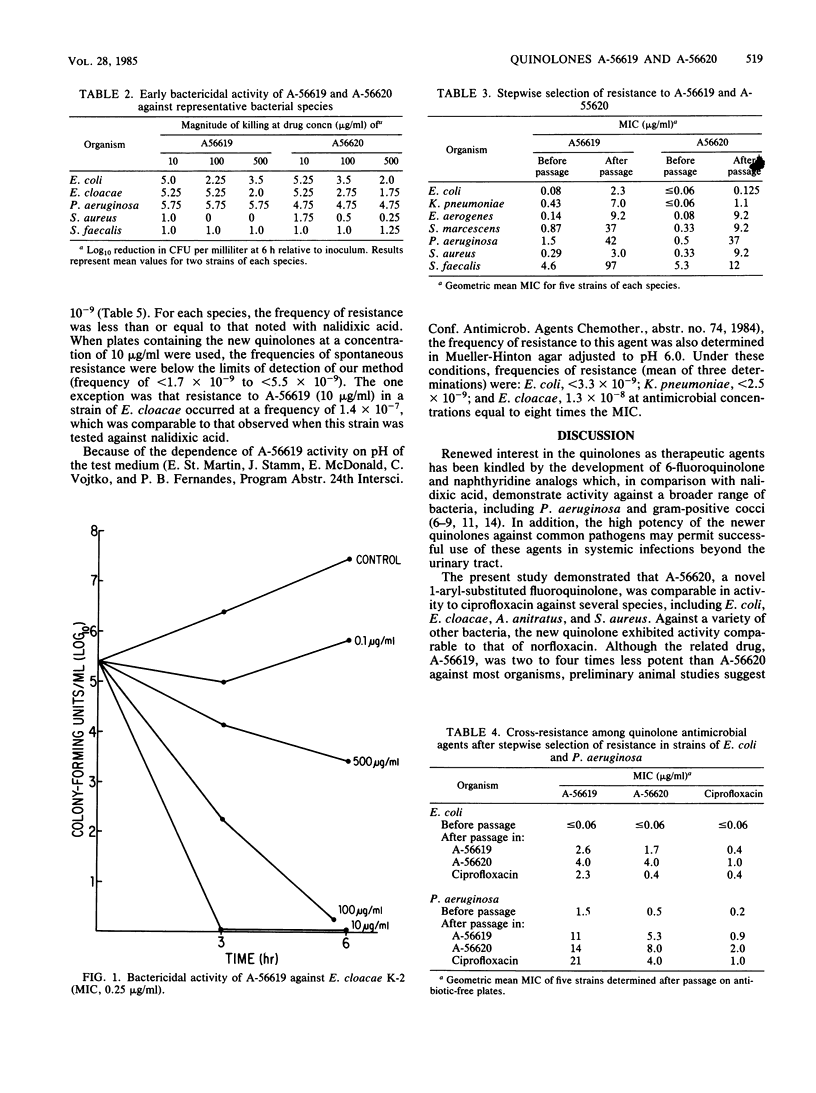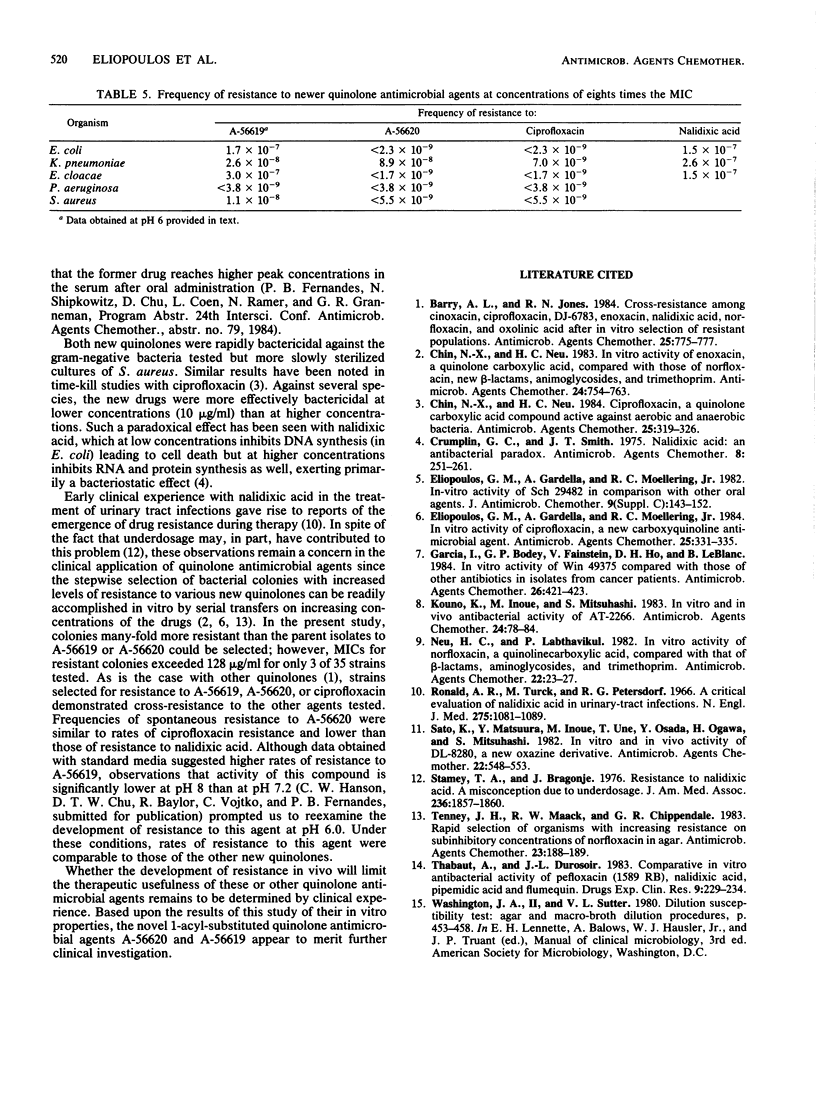Abstract
The in vitro activities of two new quinolone antimicrobial agents, A-56619 and A-56620, were compared with those of norfloxacin, ciprofloxacin, and other antimicrobial agents. The activity of A-56620 was comparable to that of ciprofloxacin against Escherichia coli, Enterobacter cloacae, and Aeromonas hydrophila (MICs for 90% of the strains were less than or equal to 0.06 micrograms/ml); Acinetobacter anitratus and Staphylococcus aureus (MIC for 90% of the strains was 0.5 micrograms/ml); and most streptococci. Against other gram-negative strains, A-56620 demonstrated activity comparable to that of norfloxacin, but the new drug was two to eight times more active than norfloxacin against gram-positive isolates. A-56620 was more active than A-56619 against most gram-negative organisms tested. Of the members of the family Enterobacteriaceae examined, 88% were inhibited by A-56619 and 99% by A-56620 at concentrations of less than or equal to 1.0 microgram/ml. By time-kill methods, the new quinolones were bactericidal against gram-negative bacilli during the first 6 h of incubation, but against S. aureus and enterococci the drugs were primarily bacteriostatic during this period. The frequency of spontaneous resistance to 10 micrograms of these drugs per ml was less than 10(-8) for all species tested except E. cloacae, but by serial passage through incremental concentrations of the antimicrobial agents, colonies many-fold more resistant than the initial isolate could be selected. However, resistance to concentrations of the drug greater than 100 micrograms/ml remained stable after passage on antibiotic-free media in only 1 of 35 strains tested.
Full text
PDF






Selected References
These references are in PubMed. This may not be the complete list of references from this article.
- Barry A. L., Jones R. N. Cross-resistance among cinoxacin, ciprofloxacin, DJ-6783, enoxacin, nalidixic acid, norfloxacin, and oxolinic acid after in vitro selection of resistant populations. Antimicrob Agents Chemother. 1984 Jun;25(6):775–777. doi: 10.1128/aac.25.6.775. [DOI] [PMC free article] [PubMed] [Google Scholar]
- Chin N. X., Neu H. C. Ciprofloxacin, a quinolone carboxylic acid compound active against aerobic and anaerobic bacteria. Antimicrob Agents Chemother. 1984 Mar;25(3):319–326. doi: 10.1128/aac.25.3.319. [DOI] [PMC free article] [PubMed] [Google Scholar]
- Chin N. X., Neu H. C. In vitro activity of enoxacin, a quinolone carboxylic acid, compared with those of norfloxacin, new beta-lactams, aminoglycosides, and trimethoprim. Antimicrob Agents Chemother. 1983 Nov;24(5):754–763. doi: 10.1128/aac.24.5.754. [DOI] [PMC free article] [PubMed] [Google Scholar]
- Crumplin G. C., Smith J. T. Nalidixic acid: an antibacterial paradox. Antimicrob Agents Chemother. 1975 Sep;8(3):251–261. doi: 10.1128/aac.8.3.251. [DOI] [PMC free article] [PubMed] [Google Scholar]
- Eliopoulos G. M., Gardella A., Moellering R. C., Jr In vitro activity of ciprofloxacin, a new carboxyquinoline antimicrobial agent. Antimicrob Agents Chemother. 1984 Mar;25(3):331–335. doi: 10.1128/aac.25.3.331. [DOI] [PMC free article] [PubMed] [Google Scholar]
- Eliopoulos G. M., Gardella A., Moellering R. C., Jr In-vitro activity of Sch 29482 in comparison with other oral antibiotics. J Antimicrob Chemother. 1982 Feb;9 (Suppl 100):143–152. doi: 10.1093/jac/9.suppl_c.143. [DOI] [PubMed] [Google Scholar]
- Garcia I., Bodey G. P., Fainstein V., Ho D. H., LeBlanc B. In vitro activity of WIN 49375 compared with those of other antibiotics in isolates from cancer patients. Antimicrob Agents Chemother. 1984 Sep;26(3):421–423. doi: 10.1128/aac.26.3.421. [DOI] [PMC free article] [PubMed] [Google Scholar]
- Kouno K., Inoue M., Mitsuhashi S. In vitro and in vivo antibacterial activity of AT-2266. Antimicrob Agents Chemother. 1983 Jul;24(1):78–84. doi: 10.1128/aac.24.1.78. [DOI] [PMC free article] [PubMed] [Google Scholar]
- Neu H. C., Labthavikul P. In vitro activity of norfloxacin, a quinolinecarboxylic acid, compared with that of beta-lactams, aminoglycosides, and trimethoprim. Antimicrob Agents Chemother. 1982 Jul;22(1):23–27. doi: 10.1128/aac.22.1.23. [DOI] [PMC free article] [PubMed] [Google Scholar]
- Ronald A. R., Turck M., Petersdorf R. G. A critical evaluation of nalidixic acid in urinary-tract infections. N Engl J Med. 1966 Nov 17;275(20):1081–1089. doi: 10.1056/NEJM196611172752001. [DOI] [PubMed] [Google Scholar]
- Sato K., Matsuura Y., Inoue M., Une T., Osada Y., Ogawa H., Mitsuhashi S. In vitro and in vivo activity of DL-8280, a new oxazine derivative. Antimicrob Agents Chemother. 1982 Oct;22(4):548–553. doi: 10.1128/aac.22.4.548. [DOI] [PMC free article] [PubMed] [Google Scholar]
- Stamey T. A., Bragonje J. Resistance to nalidixic acid. A misconception due to underdosage. JAMA. 1976 Oct 18;236(16):1857–1860. [PubMed] [Google Scholar]
- Tenney J. H., Maack R. W., Chippendale G. R. Rapid selection of organisms with increasing resistance on subinhibitory concentrations of norfloxacin in agar. Antimicrob Agents Chemother. 1983 Jan;23(1):188–189. doi: 10.1128/aac.23.1.188. [DOI] [PMC free article] [PubMed] [Google Scholar]


